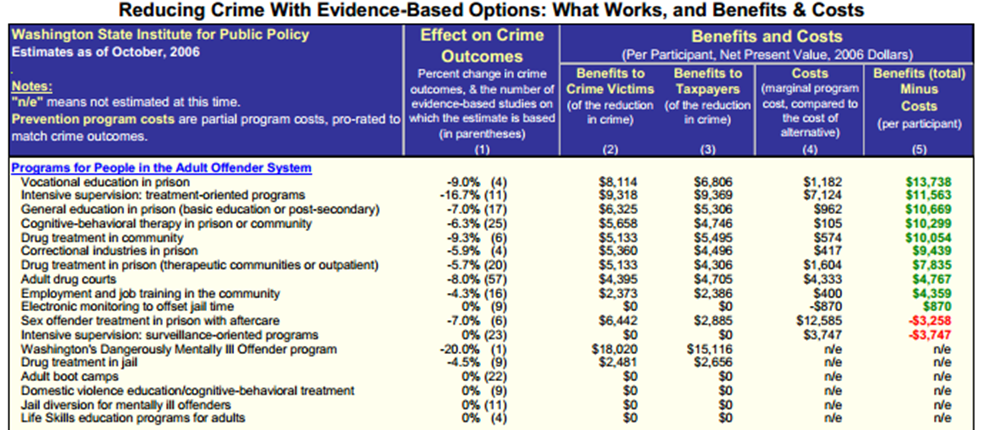Fiscal Highlights - November 2013
|
Corrections Substance Abuse Treatment -
Gary R. Syphus ( You may have already assumed that substance abuse treatment for inmates was beneficial; but, what is the most effective way to disburse substance abuse treatment resources? The Washington State Institute for Public Policy performed a study that looked at the effectiveness of programming of offenders that included various substance abuse treatment programs and included a cost-benefit analysis.
During the 2013 General Session, the Legislature internally adjusted about $2.2 million from the for substance abuse treatment within the Department of Corrections (DOC). This amounts to a total of about $8.7 million dedicated toward treatment for specific inmates linked to a form substance abuse. Beyond this there is about $900,000 given to the Department of Corrections for their supervision role in the Drug Offender Reform Act (DORA). One of the big takeaways from the report on the effectiveness of the DORA program was: "Statewide DORA participants were compared to a matched group to examine the impact of DORA on criminal justice outcomes. Results of the post-exit recidivism analyses suggested that DORA participants' outcomes were not significantly different from those of the Matched Comparison group. The findings show that, after controlling for covariates, DORA did not have a significant impact on participants when compared to similar offenders on traditional probation and parole. . . As currently implemented, DORA may not have sufficient intensity or breadth of treatment targets to adequately address the dynamic needs of the high risk population it serves. DORA's exclusive focus on substance abuse, to the exclusion of other criminogenic risk factors, may be insufficient to reduce recidivism among a high-need group of offenders." As more than 90% of all inmates will eventually be released from prison and into communities, part of DOC's responsibilities are "providing maximum opportunities for offenders to make lasting changes through accountability, treatment, education, and positive reinforcement within a safe environment." Research shows that substance abuse treatment contributes to positive outcomes in improved recidivism rates - or the rate at which they return to prison. This impacts the budget as the cost of inmates is about $25,000-29,000/year. Much of the cause of recidivism is directly or indirectly related to substance abuse problems. If treatment can help with the reasons inmates return to prison, this will likely have a positive impact on the budget as well as other socially desirable effects. Moving into the 2014 General Session, determining the right combination of substance abuse treatment programs and funding will be important. |
Capital Improvements Funding - Mark Bleazard Capital Improvements consist of projects costing less than $2,500,000 to improve an existing facili...Corrections Substance Abuse Treatment - Gary R. Syphus You may have already assumed that substance abuse treatment for inmates was beneficial; but, what i...Domestic Violence Shelters One-time Funding - Stephen C. Jardine It is anticipated domestic violence shelters will ask for ongoing funding in the 2014 General Sessi...In-depth Budget Review: Off-budget Funds and Operations - Russell T. Frandsen While Utah consistently ranks among the best managed states, legislators recognize that there is al...Internal Services Funds Review and Follow-up - Gary K. Ricks During the 2012 interim, the Office of the Legislative Fiscal Analyst issued a report and survey re...Landowner Payments for Depredation or Crop Loss - Ivan D. Djambov If big game animals are damaging cultivated crops, fences, or equipment on private land, the landow...Prison Relocation and Development Authority (PRADA) Update - Steven M. Allred The Executive Appropriations Committee recently received an update on PRADA's activities. At ...Student Enrollment in Utah's Public Schools Continues to Increase - Ben Leishman Utah schools enrolled 11,581 more students this fall than last year, for a total of 612,551. ...UCAT COE Standards - Angela J. Oh Every year, the Utah College of Applied Technology ((UCAT) produces an annual report. The report hi...Utah State University Delivers Education Statewide - Spencer C. Pratt Utah State University (USU) is the state's land-grant university, and as such, is committed to prov...What's a Dynamic Fiscal Note? - Thomas E. Young Have you ever wanted to look at the backward linkages and behavioral responses associated with your... |
Reports/Archive | Budget Process | Office Background | Who's Who | Organization Chart
Office of the Legislative
Fiscal Analyst
House Building, Suite W310
Salt Lake City, UT 84114
Phone (801) 538-1034 Fax (801) 538-1692
